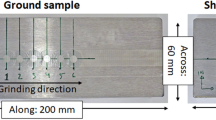Abstract
Wear processes in ball and rod mills have recently received increased attention in order to increase efficiency and conserve grinding media. Direct removal of metal from the grinding media surface by abrasive wear occurs in both dry and wet grinding. Additional corrosive wear is apparent during wet grinding, in which less resistant corrosion product films are abraded away. Inhibitors and higher pH solutions, in which corrosion product films are more tenacious, improve wear resistance during wet grinding. Softer surfaces are less resistant to corrosive wear, suggesting that film formation and subsequent film abrasion on newly furrowed surfaces must be a factor.
Similar content being viewed by others
References
Committee on Comminution and Energy Consumption, “Comminution and Energy Consumption,” NMAB-364, National Materials Advisory Board, Washington, DC, May 1981.
E.J. Pryor, Mineral Processing, 3rd. edition, Applied Science, London, 1964, p. 84.
J.F. Remark and O.J. Wick, “Corrosion Control in Ball and Rod Mills,” Paper No. 121, Corrosion/76, NACE, Houston, Texas, 1976.
F.C. Bond, “Metal Wear in Crushing and Grinding,” Chem. Eng. Prog., 60, February 1964, p. 90.
M.G. Fontana and N.D. Greene, Corrosion Engineering, 2nd edition, McGraw-Hill, New York 1986, p. 73.
J. Postlethwaite and M.W. Hawrylak, “Effect of Slurry Abrasion on the Anodic Dissolution of Iron in Water,” Corrosion, 31, 1975, p. 237.
F. Borik, “Abrasion Resistance of White Irons Used for Handling Abrasive Slurries,” Climax Molybdenum Co. Report L-212-134, Ann Arbor, Michigan, March 19, 1976.
K.A. Natarajan, S.C. Riemer and I. Iwasaki, “Ball Wear in Magnetic Taconite Grinding,” 44th Annual Mining Symposium, University of Minnesota, Duluth, Minnesota, January 1983.
J. Moore, I. Iwasaki, K. Natarajan, R. Perez, and K. Adam, “The Effect of Grinding Ball Composition and Mineral Slurry Environment on Grinding Media Wear,” to be published in Proceedings, Intl. Conf., Tribology in Mineral Extraction: War on Wear, University of Nottingham, Great Britain, September 1984.
R.J. Brigham, “Electrochemical Study of the Mechanisms of Corrosive Wear,” Can. Met. Quart., 15, (1976), p. 389.
D.L. Albright and D.J. Dunn, “Wear Behavior of Iron and Steel Castings for the Mining Industry,” Climax Molybdenum Co. Report ISJ-1306, Ann Arbor, Michigan, February 24, 1983.
D.J. Dunn, “Selection of Liners and Grinding Media for Comminution Circuits-Case Studies” in Design and Installation of Comminution Circuits, edited by A.L. Mular and G.V. Jergensen, SME-AIME, New York (1982), p. 973.
F.C. Bond, “Lab Equipment and Tests Help Predict Metal Consumption in Crushing and Grinding Units,” Engrg. Mining J., 165, (1964), p. 169.
G.R. Hoey, W. Dingley, and A.W. Lui, “Inhibitors Help to Reduce Ball Loss,” Can. Chem. Processing, May 1975, p. 36.
G.R. Hoey, W. Dingley, and C. Freeman, “Corrosion Inhibitors Reduce Ball Wear in Grinding Sulfide Ore,” CIM Bulletin, 68, (1975), p. 120.
A.W. Lui and G.R. Hoey, “Mechanisms of Corrosive Wear of Steel Balls in Grinding Hematite Ore,” Can. Met. Quart., 14, (1975), p. 281.
K.A. Natarajan, S.C. Riemer, and I. Iwasaki, “Corrosive and Erosive Wear in Magnetic Taconite Grinding,” Preprint No. 83-602, SME-AIME Annual Meeting, Atlanta, Georgia, March 6–10, 1983.
K.A. Natarajan, S.C. Riemer and I. Iwasaki, “Ball Wear in Magnetic Taconite Grinding,” Annual Meeting Minnesota Section AIME, Duluth, Minneapolis, January 12, 13, 1983.
J.J. Moore, R. Perez and R. Grozdanich, “Wear Mechanisms in Grinding Media,” ibid.
R. Perez and J.J. Moore, “The Influence of Grinding Ball Composition and Wet Grinding Conditions on Metal Wear,” Proceedings, International Conference on Wear of Materials, ASME, Reston, Virginia, April 1983.
Additional information
Editor’s Note: This paper was adapted from a presentation at Corrosion 85, March 25–29, 1985, in Boston, Massachusetts.
D.A. Jones received his Ph.D. in materials from Rensselaer Polytechnic Institute in 1966. He is currently a Professor in the Department of Chemical and Metallurgical Engineering at the University of Nevada-Reno. Dr. Jones is also a member of TMS-AIME.
Rights and permissions
About this article
Cite this article
Jones, D.A. Corrosive Wear in Wet Ore Grinding Systems. JOM 37, 20–23 (1985). https://doi.org/10.1007/BF03257703
Published:
Issue Date:
DOI: https://doi.org/10.1007/BF03257703




